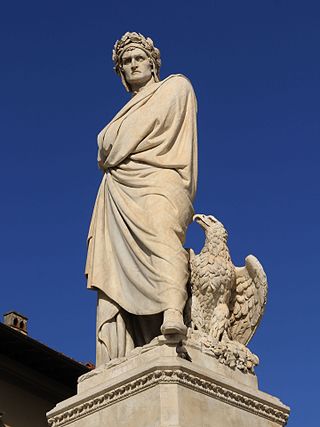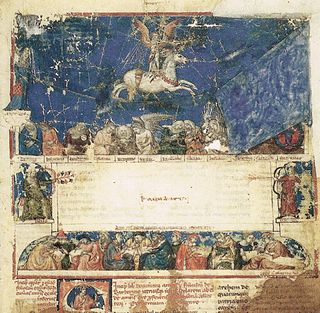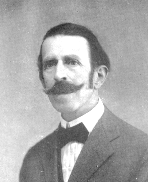Related Research Articles

Dante Alighieri, most likely baptized Durante di Alighiero degli Alighieri and often referred to as Dante, was a Florentine poet, writer, and philosopher. His Divine Comedy, originally called Comedìa and later christened Divina by Giovanni Boccaccio, is widely considered one of the most important poems of the Middle Ages and the greatest literary work in the Italian language.

Giovanni Boccaccio was an Italian writer, poet, correspondent of Petrarch, and an important Renaissance humanist. Born in the town of Certaldo, he became so well known as a writer that he was sometimes simply known as "the Certaldese" and one of the most important figures in the European literary panorama of the fourteenth century. Some scholars define him as the greatest European prose writer of his time, a versatile writer who amalgamated different literary trends and genres, making them converge in original works, thanks to a creative activity exercised under the banner of experimentalism.

The Divine Comedy is an Italian narrative poem by Dante Alighieri, begun c. 1308 and completed around 1321, shortly before the author's death. It is widely considered the pre-eminent work in Italian literature and one of the greatest works of Western literature. The poem's imaginative vision of the afterlife is representative of the medieval worldview as it existed in the Western Church by the 14th century. It helped establish the Tuscan language, in which it is written, as the standardized Italian language. It is divided into three parts: Inferno, Purgatorio, and Paradiso.

Publius Vergilius Maro, usually called Virgil or Vergil in English, was an ancient Roman poet of the Augustan period. He composed three of the most famous poems in Latin literature: the Eclogues, the Georgics, and the epic Aeneid. A number of minor poems, collected in the Appendix Vergiliana, were attributed to him in ancient times, but modern scholars consider his authorship of these poems to be dubious.

Pietro Bembo, O.S.I.H. was an Italian scholar, poet, and literary theorist who also was a member of the Knights Hospitaller, and a cardinal of the Roman Catholic Church. As an intellectual of the Italian Renaissance, Pietro Bembo greatly influenced the development of the Tuscan dialect as a literary language for poetry and prose, which, by later codification into a standard language, became the modern Italian language. In the 16th century, Bembo's poetry, essays and books proved basic to reviving interest in the literary works of Petrarch. In the field of music, Bembo's literary writing techniques helped composers develop the techniques of musical composition that made the madrigal the most important secular music of 16th-century Italy.

La Vita Nuova or Vita Nova is a text by Dante Alighieri published in 1294. It is an expression of the medieval genre of courtly love in a prosimetrum style, a combination of both prose and verse.

Brunetto Latini was an Italian philosopher, scholar, notary, politician and statesman.

Guido Cavalcanti was an Italian poet. He was also a friend and intellectual influence on Dante Alighieri.

Italian literature is written in the Italian language, particularly within Italy. It may also refer to literature written by Italians or in other languages spoken in Italy, often languages that are closely related to modern Italian, including regional varieties and vernacular dialects.

Giovanni Placido Agostino Pascoli was an Italian poet, classical scholar and an emblematic figure of Italian literature in the late nineteenth century. Alongside Gabriele D'Annunzio, he was one of the greatest Italian decadent poets.

Cino da Pistoia was an Italian jurist and poet. He was the university teacher of Bartolus de Saxoferrato and a friend and intellectual influence on Dante Alighieri.
Massimiliano Chiamenti was an Italian poet and philologist who lived in Bologna, and taught at the "Liceo delle Scienze Sociali Laura Bassi and the "Liceo Scientifico Leonardo Da vinci"".
Jacopo Alighieri was an Italian poet, the son of Dante Alighieri, whom he followed in his exile. Jacopo's most famous work is his sixty-chapter Dottrinale. He is represented by his father in the Paradiso of the Divine Comedy as Saint James along with Saint Peter and Saint John the Evangelist, representing his brothers Pietro and Giovanni.
Bucolicum carmen is an organic collection of twelve eclogues, composed by Petrarch from c. 1346–7 and published in 1357. The last (Aggelos) contains the dedication of the sylloge to Donato Albanzani.

Eclogue 4, also known as the Fourth Eclogue, is the name of a Latin poem by the Roman poet Virgil. Part of his first major work, the Eclogues, the piece was written around 40 BC, during a time of brief stability following the Treaty of Brundisium; it was later published in and around the years 39–38 BC. The work describes the birth of a boy, a supposed savior, who once of age will become divine and eventually rule over the world. During late antiquity and the Middle Ages, a desire emerged to view Virgil as a virtuous pagan, and as such the early Christian theologian Lactantius, and St. Augustine—to varying degrees—reinterpreted the poem to be about the birth of Jesus Christ.

The Statue of Dante Alighieri is a monument to Dante Alighieri in Piazza Santa Croce, outside the Basilica of Santa Croce, in Florence, Italy. Erected in 1865, it is the work of the sculptor Enrico Pazzi.
Bernardo Canaccio was an Italian poet.

Francesco di Neri di Ranuccio, known better as Francesco da Barberino (1264–1348), was a Tuscan notary, doctor of law and author.

Giuseppe Albini was an Italian philologist, Latinist and politician.